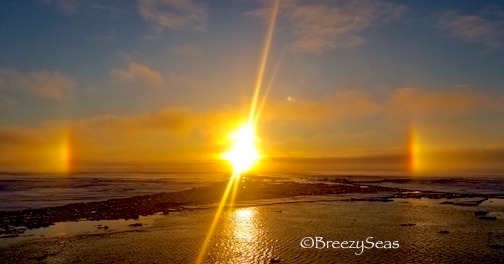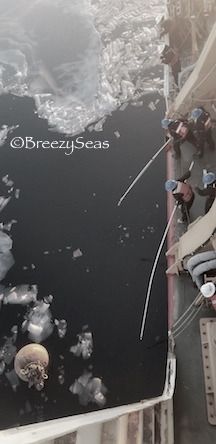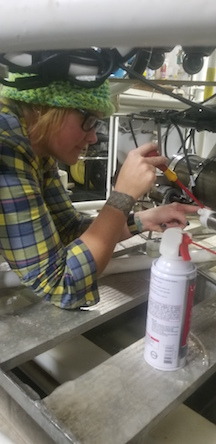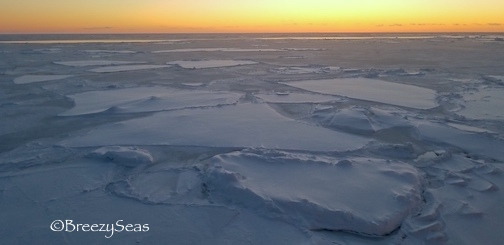Week 2: Shoot for the STARcS
Breezy Grenier on the USCGC Healy: Allure of the Arctic! Its almost been a week since we entered the Realm of the Blue Nose, and things are surely turning blue! Working on a boat is one thing, working on a boat in the Arctic is a whole different story. A good majority of our work is to keep equipment from freezing.

Living aboard a ship is nothing new to me, being a Coast Guard Veteran, having steamed around the Antarctic Peninsula and Scotia Arc with the Geological Society of America, sailed around New Zealand, with SEA Semester’s Global Ocean Program, I even have served as expedition staff aboard a Russian Nuclear Ice Breaker to the Geographic North Pole. As a licensed captain, having worked on charters, boat deliveries, and even fishing, diving, and service support vessels, I have put on many miles at sea (almost four years documented sea time last time I checked). I have spent time out on the Okeanos Explorer as a mapping watch stander with the Explorer-in-Training program out in the Western Pacific before, but the experience of living and working aboard a research vessel always feels new to me. Having a “9-5 schedule” let alone while at sea, is completely the opposite of what I am use to. From working several seasonal jobs and employment contracts, my land schedule is always changing day to day. While at sea, I am use to rotating watch schedules, on top of a daily work schedule. Serving as a captain of vessel you are always on call, but here I worked every day from 0600 to1800 (6am to 6pm) ships time. Meals are always served at the same time. The daily duties change, but the repetition does not. The closest thing to standard routine I am use to is when my animals (puppy, dog, cat, and parrot) wake me up each morning. It’s a nice change of pace (aside from missing my fur balls). When your schedule is predictable, you can get a lot more accomplished when you are smart with your time, so I am quickly knocking out tasks (such as updating SOPs and work manuals) and working on new projects to keep busy.
If you haven’t been following, I am serving my internship with STARC (Ship-based Technical Support in the Arctic) as a Tech Watch stander, and WHOI (Woods Hole Oceanographic Institute) is our science team aboard the Coast Guard Cutter Healy, a polar icebreaker. The primary focus of our work is moorings and CTD casts. CTD stands for conductivity, temperature, and depth (pressure) of seawater. To paint a picture, we are around 72° North, in the Arctic Ocean. Our current area is off Prudhoe Bay, North Slope in Alaska, in November. So ice is forming all around us, day is turning to night, and temperatures are dropping. Right now we have about 5 hours of daylight. Sun rises at lunch and sets at dinner. We are limited to recovering and deploying moorings during daylight hours (obvious safety reasons), so that does put some restrictions on our CTD cast transects (we have to sometimes break away to go recover a mooring).

The portable heater in our CTD compartment is broken, and so is the back up. The space is still heated, but pulling equipment out from the water, even just a minute, below freezing temperatures with wet equipment, is not good. We have been getting around the lack of heat by flushing the pumps with room temperature salt water, then slowly adding warmer saltwater, to bring them up from below freezing every time the CTD cast comes back aboard, so it is ready for redeployment. We also use a heat gun (much like a hair dryer) on some of the equipment parts to unfreeze them, being extremely careful, not to damage any of the sensors. Our saltwater flow system on the ship was even getting clogged with ice chunks. We’ve been busy.

Photo Credit: Brandon D'Andrea
Still nothing is better than stepping outside, in the clean, crisp, Arctic Air and watching jaw-dropping icescapes. We have been lucky enough to catch a glimpse of an Arctic fox out on the ice, ring seals sunning, and even a polar bear mother with her two [one year old] cubs, not to mention seabirds. We also got a glimpse of the Aurora, peeking between the clouds one night. We are entering a high-pressure system, and with a waning moon, it will give us more optimal conditions for viewing, fingers crossed! The sunset on Halloween blessed us with a sight of perihelia sun arcs! Also known as sundogs and ice halos. Think of a rainbow, but the arcs are reversed. When you see sundogs, it’s a sailor’s weather prediction that snow is coming, and lo and behold, it started to snow an hour later.
We are continuing to push east, as far as the ice allows us. Stay warm!

